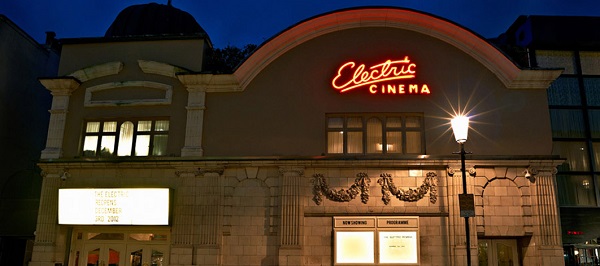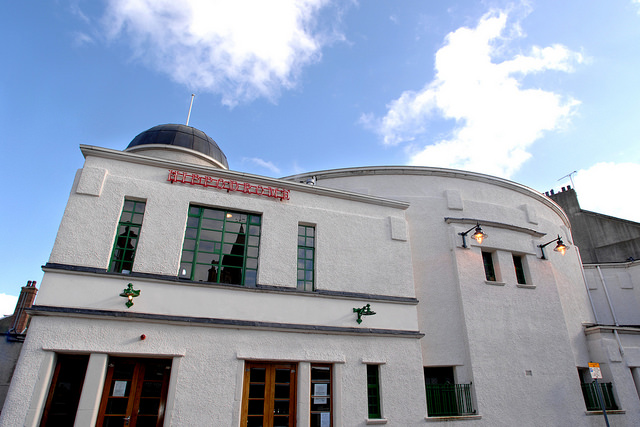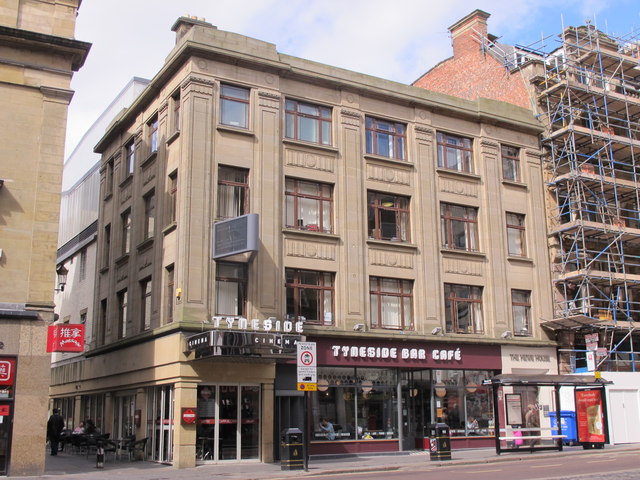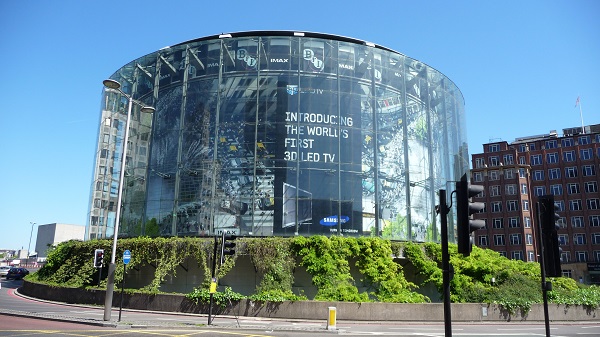Main author
Michael BrooksBest cinema architecture in the UK
Designing Buildings have highlighted some of the best examples of cinema architecture in the UK.
Have we missed out a great example? Let us know in the Comments section below.
[edit] Phoenix – East Finchley, London
Image © Maurita van Droogenbroeck
Built in 1910, the Phoenix was redesigned and rebuilt in an Art Deco style in 1937. The original Edwardian barrel vault ceiling was retained, but the auditorium itself was reversed, and decorative panels added along the walls.
In 1999, the cinema was given Grade-II listed status, and to celebrate its centenary, in 2010, it underwent renovation. This included the restoration of the vaulted ceiling and the distinctive neon sign, and the addition of a glazed balcony projected out from the first floor cafe-bar.
[edit] Ritzy Picturehouse – Brixton, London
This Grade-II listed cinema originally opened in 1911 as the 'Electric Pavilion', situated at the lively centre of Brixton, Windrush Square.
The main auditorium is distinct for its original Edwardian plasterwork, ceiling ribs and paneled walls, as well as the original proscenium arch characteristic of period theatres.
Despite having been damaged by bombs during WW2, and facing demolition in the 1970s, its fortunes have resurged in the last two decades, with significant restoration works, and is now one of the most popular cinemas in South London.
[edit] Plaza – Truro
The Plaza in Truro, Cornwall, opened in 1936, designed by the Bristol-based cinema architect William Henry Watkins.
The cinema is typical of the Art Deco style of the time, with five tall and thin windows topped with a gentle curve, each side flanked by an additional window with decorative concrete features.
[edit] Electric – Notting Hill, London
The Electric Cinema, on Notting Hill's Portobello Road, first opened in 1910. It was designed by architect Gerald Seymour Valentin in the Edwardian Baroque style.
The cinema's popularity grew as the demand for entertainment surged following WW2, however, its fortunes faded as the area of Notting Hill became a place of racial tension and crime. It came to be known as the 'bunghole' as it fell increasingly into disrepair.
Having redeveloped and renamed itself several times without success, it closed permanently in 1993. Local property developers acquired the site in the late-1990s and set about restoring it to its former glory. Today, the Electric Cinema is one of London's most iconic film-viewing locations, distinctive for its deep red leather armchairs and accompanying stool and lamp.
[edit] Odeon – Harrogate
The Harrogate Odeon opened in 1936 and is considered one of the UK's finest Modernist cinema buildings. It was awarded Grade-II listed status in 1988.
It was designed by architect Cecil Clavering in the 'Streamlined Moderne' style, comprising a curved entrance canopy, tall slender Art Deco 'fin' tower, biscuit-coloured faience tiles and brick-faced auditorium.
Projecting bands of darker-brown brick break up the top section, with the bands continuing down the tower's face on the southern side. Tall windows extend through both ground- and first-floor, with shorter windows to the second-floor.
[edit] Broadway Cinema – Nottingham
(Image © Ashley Bird)
Broadway Cinema was originally a church that was built in 1839 by the architect S. S. Rawlinson. Legend has it that William Booth was converted there, before going on to found the Salvation Army.
Having served as cinemas in various incarnations from the 1960s, in 2006, the Broadway was redeveloped and enlarged. Site investigation works had to ascertain whether there were any hidden voids beneath the surface before excavation began for the basement level as the building is founded on sandstone.
An all-glazed 'box' was designed to create a light entrance space at the ground floor, as well as forming balconies at the first and second floors. This was carefully designed to thread around the existing colonnades without adding load to their weak masonry superstructure.
The expansion also included the one-of-a-kind auditorium (Screen 4) designed by the legendary Sir Paul Smith, featuring his trademark stripe.
In 2009, the cinema was rated as one of the 'best in the world' by Total Film magazine.
[edit] Dome – Worthing
(Image © Pete Holmes)
(Image © Gary Levett)
'Kursaal' was a German term used to refer to an Edwardian-period leisure and entertainment centre, that was adopted by the British in the 1880s. The Worthing Dome is a rare surviving example of one such kursaal.
The building originally opened in 1911 as a rollerskating rink, but later in the same year a cinema opened as well. This was later converted to a dance hall, then a bingo hall, and then returned to being a cinema again in 1999.
After numerous council issues and local campaigning, enough investment was found to secure the structural stability of the dome and ensure its continued operation.
[edit] Hippodrome – Bo’ness, Falkirk
(Images © Falkirk Community Trust, Arts & Heritage)
Dating back to 1912, this is a rare example of pre-Art Deco cinema architecture, and is believed to be Scotland's oldest picturehouse.
It was designed by local architect Matthew Steele and constructed on a corner site. This necessitated the Hippodrome's circular auditorium with wraparound gallery facing a traditional proscenium and small stage. A domed roof and ticket office were both added in 1926 by Steele.
In the mid-1970s it became a bingo hall until it was closed in 1980 and abandoned. Lead by Scottish Historic Buildings Trust, the cinema was renovated and reinstated, opening again in 2008. This included the restoration of the 1926 decorative scheme and original seating.
[edit] Tyneside Cinema – Newcastle-upon-Tyne
[edit] Plaza – Stockport
(Images ©The Stockport Plaza Trust)
This Art Deco cinema was designed by William Thornley and constructed in 1932 in a project that required the excavation of 10,000 tonnes of sandstone from the site. The building is brick with front faience cladding, with internal structural steelwork.
The Plaza was converted into a bingo hall in 1967. A National Lottery-funded restoration took place in 2009, returning the building to its original 1932 configuration. The entire facade was restored to its original cream ensemble.
The Plaza is also notable for its Compton Theatre Organ, the first to be built with sunburst decorative glass panels.
[edit] Rio – Dalston, London
This Grade-II listed neo-classical cinema originally opened in 1915, designed by architects Percy C. Adams and George Coles of the architectural firm Adams & Coles. In 1937 it was refurbished in the Art Deco style by F. E. Bromige.
Bromige created a new auditorium within the shell of the 1915 original which is, according to Heritage England, 'highly unusual'. There is a secret door on the Rio's roof through which can be seen the ceiling and upper walls of the original.
The striking Art Deco ceiling curves smoothly down to the screen, which is flanked by golden stylised organ vents. The blue and pink interior was restored in 1997, remaining faithful to Bromige's design. The Rio also features a traditional box office at the main doorway, and quirky leopard print carpet throughout.
[edit] Warwick Arts Centre – Warwick
Warwick Arts Centre is a multi-purpose venue at the University of Warwick in Coventry. The first phase was built in 1974 and further extended twice in the 1980s. In addition to a cinema, the venue includes a concert hall, two theatres, a music centre, the Mead Art Gallery, conference facilities, restaurants and a bookshop.
In 1997, the Arts Centre was renovated, which included installing a new glass atrium roof in the foyer and lift access to the upper floors.
[edit] Barn Cinema - Totnes
(Images © Original Image Photography)
The Barn Cinema is located within the idyllic grounds of the Darlington Hall Estate, near Totnes.
Not much is known about its early history, but it is estimated that the Grade-I listed building was built in the late-1500s. The exterior of the barn was reconstructed during the early-1930s, and it was converted into a theatre between 1933-38.
The Barn first began operating as a cinema in the 1970s, and it underwent a major refurbishment in 1996.
[edit] Harbour Lights - Southampton
This purpose-built cinema was a joint project between Southampton City Council and the British Film Institute (BFI). It was designed by architects Burrell Foley Fisher, and opened in 1995.
The cinema's exterior is a striking glass design, with two elevated interior walkways that lead into one of the two screens. The glass artwork is structurally integral to the south elevation of the foyer extension. The background to the design comprises two large blue forms loosely based on a 35mm and 70mm film frames.
The building was shortlisted for The Sunday Times/Royal Fine Art Commission Building of the Year Award 1995 and gained a Civic Trust Commendation 1997. Harbour Lights is attributed with having had a leading influence on the design of a new generation of cinemas.
[edit] The Rex Cinema - Berkhamsted
[edit] Hyde Park Picturehouse - Leeds
(Images © Tom Joy)
[edit] Broadway - Letchworth
[edit] BFI Imax - London
[edit] Related articles on Designing Buildings
- An art deco cinema on wartime Orkney.
- Architecture of concert stage designs.
- Assets of community value.
- Bandstand.
- Best gym architecture in the world.
- Buildings in film.
- Buildings in music.
- Building of the week series.
- Conservation of the historic environment.
- Lillehammer Art Museum and Cinema.
- Live event production.
- London’s West End Cinemas.
- Stool.
- Unusual building design of the week.
Featured articles and news
Homes England creates largest housing-led site in the North
Successful, 34 hectare land acquisition with the residential allocation now completed.
Scottish apprenticeship training proposals
General support although better accountability and transparency is sought.
The history of building regulations
A story of belated action in response to crisis.
Moisture, fire safety and emerging trends in living walls
How wet is your wall?
Current policy explained and newly published consultation by the UK and Welsh Governments.
British architecture 1919–39. Book review.
Conservation of listed prefabs in Moseley.
Energy industry calls for urgent reform.
Heritage staff wellbeing at work survey.
A five minute introduction.
50th Golden anniversary ECA Edmundson apprentice award
Showcasing the very best electrotechnical and engineering services for half a century.
Welsh government consults on HRBs and reg changes
Seeking feedback on a new regulatory regime and a broad range of issues.
CIOB Client Guide (2nd edition) March 2025
Free download covering statutory dutyholder roles under the Building Safety Act and much more.
Minister quizzed, as responsibility transfers to MHCLG and BSR publishes new building control guidance.
UK environmental regulations reform 2025
Amid wider new approaches to ensure regulators and regulation support growth.
BSRIA Statutory Compliance Inspection Checklist
BG80/2025 now significantly updated to include requirements related to important changes in legislation.
























































Comments
Longford/Essoldo Cinema, Stretford, Manchester
The Regal Cinema, Evesham
The Granada, Tooting, surely one of the greatest!
The lovely Art Deco "Electric Palace" Bridport.
Savoy Heaton Moor
Regal Melton Mowbray
Rex Wilmslow
Ritz Belper